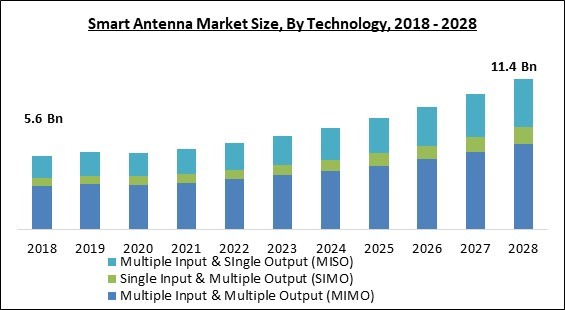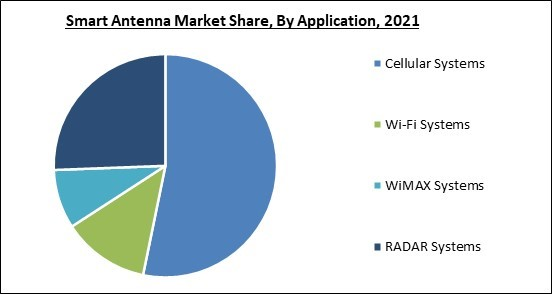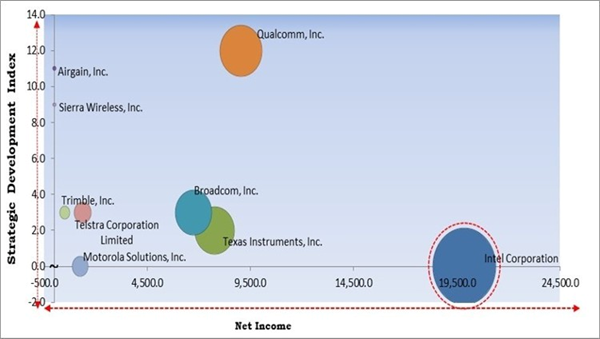Smart antennasare utilizedin digital wireless communication systems to improve efficiency. It operates by taking use of the diversity impact at the source and destination transceivers of the wireless system. The phrase 'diversity effect' involves the broadcasting and reception of many radio frequencies to reduce data communication error while also increasing data speed among the source and destination.
This technique is already being utilized in most wireless communication systems, where dedicated antenna arrays are combined with signal processing algorithms to detect and track various wireless objects like mobile phones. It's also utilized to figure out the signal's beam making vectors & direction of arrival [DOA].
The key distinction is in how both systems handle difficulties induced by multipath wave propagation. Whenever a wireless signal is delivered over a long distance, this could encounter numerous obstacles such as big buildings, mountains, and utility wires. As a result, the wave fronts of these signals will be fragmented and travel different courses to reach the receiver. A method known as Single input Single output [SISO] is utilized in a traditional wi-fi communication system, in which Single antenna is linked to the source and the other to the destination. Whenever signals arrive late at their destination, they could be faded, cut-out, or have other frequent communication issues, such as picket fencing.
The sector has also opened up chances for production and maintenance systems to keep the items in good working order. Product development is gradual & directly proportional to technological improvements in this market because it is a technical business. The market is mostly focused on the commercial sector and has a broad range of applications.
COVID-19 Impact Analysis
As a consequence of the COVID-19 pandemic outbreak, the smart antenna was severely damaged. During the early phases of the pandemic, the technology was in high demand because it allowed for secure and quick remote work solutions; however, manufacturing of smart antennas was hampered as a result of lockdowns or factory closures. But, since then, the market has taken advantage of the crisis to grow into hitherto untouched areas. Flexibility for future frequencies has also been added to the market, attempting to make items more durable and appealing.Market Growth Factors
There Is A Considerable Demand For Technically Sophisticated Military Equipment To Substitute Traditional Military Equipment
As warfare & battlefield management have evolved, the need to upgrade traditional military equipment has grown. To keep up with technological improvements on the battlefield, defensive systems must be modernized, and this demand is expected to move the industry ahead. Modernization aims to raise quality, close capacity gaps, and reduce total costs. Military system advancements like as tactical radar systems, travelling wave antennas, moveable tactics, loop antennas,light weapons, updated antennas, and other goods have seen a rise in major contracts between key defense businesses and the US government.Rise In The Use Of Smart Antenna In Automotive Sector
Manufacturers have been concentrating on developing new goods for certain applications due to the fact that demand varies depending on the application. Smart antennas have become increasingly popular in the automotive industry as they improve the overall performance of wireless communication by delivering benefits like power control, range extension,multiple access interference, signal fading reduction, and multipath management. Additionally, as vehicle networking technology advances and the electric car market expands, the need of smart antennas may grow even more.Market Restraining Factors
Huge Cost Attached To Smart Antenna
Smartantennas are used for a variety of applications, including surveillance and communication, electronic warfare, and others. With the advancement of technology in defence equipment, the antenna must be developed for interoperability with other devices. Unfortunately, antenna technology R&D is expensive owing to its complexity in design and high development expenses. The development, implementation, and management of this equipment across segments are all exceedingly expensive. As a result, these factors are expected to have a negative impact on market growth.Application Outlook
Based on application, the smart antenna market is divided into Wi-Fi Systems, WiMAX Systems, Cellular Systems and RADAR Systems. The cellular systems segment procured the highest revenue share in the smart antenna market in 2021. Cellular systems are the most common use for smart antennas.WiMAX, RADAR,and Wi-Fi networks are some of the other popular uses for smart antennas. To improve signal strength & quality, smart antennas utilize a cluster of input & output antennas. This method was widely used to implement4G and 5G networks using smart antennas.Technology Outlook
On the basis of technology, the smart antenna market is classified into SIMO (Single Input & Multiple Output), MIMO (Multiple Input & Multiple Output) and MISO (Multiple Input & Single Output). SIMO segment recorded a substantial revenue share in the smart antenna market in 2021. This approach employs a Single antenna at the origin and several antennas at the recipient. In addition, there are many companies that are increasingly investing in R&D activities in order to introduce various products and solutions.Regional Outlook
Region-wise, the smart antenna market is analyzed across North America, Europe, Asia Pacific and LAMEA. North America emerged as the leading region in the smart antenna market with the maximum revenue share in 2021. Due to strong smartphone penetration and high-level 5G smart antenna requirements, the region is functioning well. Owing to early adoption, the industry has a well-established foundation of important companies in the North American region. Rapid technological development and implementation has also led to a high year-over-year performance in the region.Cardinal Matrix-Smart Antenna Market Competition Analysis
The major strategies followed by the market participants are Product Launches. Based on the Analysis presented in the Cardinal matrix; Intel Corporation is the forerunner in the Smart Antenna Market. Companies such as Broadcom, Inc., Texas Instruments, Inc. and Qualcomm, Inc. are some of the key innovators in Smart Antenna Market.
The market research report covers the analysis of key stake holders of the market. Key companies profiled in the report include Texas Instruments, Inc., Intel Corporation, Sierra Wireless, Inc., Airgain, Inc., Qualcomm, Inc., Broadcom, Inc., Telstra Corporation Limited, Trimble, Inc., Motorola Solutions, Inc., and Linx Technologies.
Strategies Deployed in Smart Antenna Market
Partnerships, Collaborations and Agreements:
- Apr-2022: Airgain teamed up with Mobix Labs, a global connectivity solutions provider. This collaboration aimed at the development of products to substantially decrease the cost of ownership and offer solutions in 5G coverage gaps amongst carriers, which is expected to fall under high-band mmWave and C-band operating frequencies. The collaboration is expected to offer new growth opportunities for the companies as the integrated solution that serve various industries like IoT, infrastructure, consumer electronics, automotive, and also high-reliability military, and aerospace applications.
- Mar-2022: Sierra Wireless expanded its agreement with T-Mobile, the 5G leader, with the largest and fastest nationwide 5G network in the United States, bolstering its global Low Power Wide Area (LPWA) connectivity offering via its Smart Connectivity service. This agreement with T-Mobile further strengthens Sierra Wireless’ IoT connectivity offering by combining our purpose-built IoT network and management tools coupled with LPWA, 4G LTE, and 5G coverage from T-Mobile’s powerful mobile network.
- Nov-2020: Texas Instruments (TI) teamed up Xilinx, an American technology and semiconductor company. This collaboration aimed to develop scalable and adaptable digital front-end (DFE) solutions to boost the energy efficiency of lower antenna count radios.
Product Launches and Product Expansions:
- May-2022: Qualcomm Technologies launched the latest capabilities and milestones for the Snapdragon X70 5G Modem-RF System. This system offers improved capabilities like Qualcomm 5G AI Suite, uplink carrier aggregation, Qualcomm 5G PowerSave Gen 3, Qualcomm 5G Ultra-Low Latency Suite, standalone mmWave, and 4X sub-6 carrier aggregation to get unprecedented 5G performance.
- Mar-2022: Sierra Wireless launched a new global private access point name (APN) solution. This solution is a simplified staging that offers effortless flexibility and security for users, boosting application deployment. With Sierra Wireless’ private APN, Sierra Wireless Smart Connectivity users is expected to no longer require making multiple SKU configurations on the edge and could develop devices with one single APN that is then translated into various private APN’s within Sierra’s core network.
- Oct-2021: Qualcomm Technologies introduced the Qualcomm ultraBAW RF filter technology for bands up to 7 GHz. This launch is an additional innovation that is developed on the company’s modem-to-antenna solution driving high-performance 5G and connectivity systems within wireless product segments.
- Feb-2021: Qualcomm Technologies unveiled the Snapdragon X65 5G Modem-RF System, its fourth-generation 5G modem-to-antenna solution. This system is the Company’s big leap in 5G solutions as the commercialization of its first modem-RF system. In addition, this system is developed to help the fastest 5G speeds accessible with fiber-like wireless performance and is expected to make the best usage of available spectrum for ultimate network capacity, flexibility, and coverage.
- May-2020: Airgain released AirgainConnect AC-HPUE, the first antenna modem from its AirgainConnect platform. This AirgainConnect AC-HPUE comprises an integrated FirstNet Ready high-power LTE modem aiding the 3GPP Band 14 High Power UE output power functionality. In addition, the rugged vehicle antenna-modem solution is expected to stiffly integrate important LTE radio components to fulfill the most demanding requirements of public safety & fleet vehicles.
- Feb-2020: Broadcom released the world’s first Wi-Fi 6E client device, the BCM4389. This device offers over 2 Gbps of real-world speeds and up to five times improved battery usage, which is expected to make it a perfect solution for flagship smartphones and advanced AR/VR devices. In addition, the BCM4389 is expected to bring improved multi-radio technology to Bluetooth.
Acquisition, Joint Venture and Merger:
- Jan-2021: Airgain took over NimbeLink Corp., a leader in the cellular industrial Internet of Things solutions and services. This acquisition aimed to integrate modem products and asset tracking solutions to Airgain’s ongoing strategy to expand its influence in the multi-billion-dollar Industrial IoT and M2M (machine-to-machine) markets.
- Jan-2020: Sierra Wireless took over M2M group of companies. This acquisition aimed to expand Sierra Wireless’ IoT solutions business in the Asia-Pacific region. The business is expected to have an excellent strategic fit with Sierra's IoT Solutions business with slightly more than half of the M2M Group’s revenue coming from subscription-based recurring revenue.
Scope of the Study
Market Segments Covered in the Report:
By Application
- Cellular Systems
- Wi-Fi Systems
- WiMAX Systems
- RADAR Systems
- Multiple Input & Multiple Output (MIMO)
- Single Input & Multiple Output (SIMO)
- Multiple Input & Single Output (MISO)
- North America
- US
- Canada
- Mexico
- Rest of North America
- Europe
- Germany
- UK
- France
- Russia
- Spain
- Italy
- Rest of Europe
- Asia Pacific
- China
- Japan
- India
- South Korea
- Singapore
- Malaysia
- Rest of Asia Pacific
- LAMEA
- Brazil
- Argentina
- UAE
- Saudi Arabia
- South Africa
- Nigeria
- Rest of LAMEA
Key Market Players
List of Companies Profiled in the Report:
- Texas Instruments, Inc.
- Intel Corporation
- Sierra Wireless, Inc.
- Airgain, Inc.
- Qualcomm, Inc.
- Broadcom, Inc.
- Telstra Corporation Limited
- Trimble, Inc.
- Motorola Solutions, Inc.
- Linx Technologies
Unique Offerings from the Publisher
- Exhaustive coverage
- The highest number of Market tables and figures
- Subscription-based model available
- Guaranteed best price
- Assured post sales research support with 10% customization free
Table of Contents
Companies Mentioned
- Texas Instruments, Inc.
- Intel Corporation
- Sierra Wireless, Inc.
- Airgain, Inc.
- Qualcomm, Inc.
- Broadcom, Inc.
- Telstra Corporation Limited
- Trimble, Inc.
- Motorola Solutions, Inc.
- Linx Technologies











